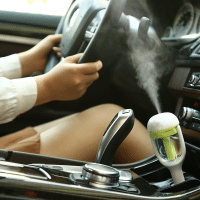You can put essential oils in your vaporizer or humidifier diffuser (not portable house humidifiers). Be sure to check with the instructions that came with each brand of diffuser you might have.
Some diffuser brands do not function with citrus oils. Be sure to check the diffuser type and brand(s) that can use lemon, orange, and grapefruit citrus oils or citrus blends.
You might first like to know the amount of drops in a mL (millimeter). A 5 mL bottle has about 100 drops, and a 15 mL bottle has about 300 drops, and this depends on the thickness of the oils.
Check your Ultrasonic diffuser instructions to know the amount of drops to use for specific diffuser brands and the type of essential oils you plan to use.
Some manufacturer’s brands will say in the instructions that tap water is okay to use. You might have hard water mineral buildup with tap water. You can clean it with clear distilled vinegar or alcohol or you can opt for distilled water and have no minerals accumulating on the bottom and sides.
To prevent moisture from damaging your furniture around the diffuser, sit it on a plant tray or an old plate. Not all diffusers mist in a downward way. If they do, elevate the diffuser on a box made of plastic that can easily be cleaned of any moisture.
This depends on how often you use it in terms of hours and days—constant use or occasional use. The instructions will explain the cleaning methods and when to do it. Usually, a dishwashing soap with water and a cotton swab is sufficient. Some brands include cleaning brushes with the unit. Do not let stale water sit in your diffuser because mold and bacteria will grow. If that happens, you will need to disinfect your unit. To disinfect, your instructions will tell you what to use: a little alcohol, peroxide, or vinegar will refresh your unit for its next use.
Not all diffusers are created equally. Some brands are made to use citrus oils and some are not. If you want to use citrus essential oils or citrus blends, be sure to choose a diffuser that allows this procedure. There are many choices here.
This again depends on your diffuser and the type of essential oil to be used. Some diffuser brands will tell you 3-5 drops and others will say up to 10 drops. You will need to read the instructions that came with the diffuser and check the label on the oils.
Less is more. The essential oils are powerful but not to worry. For example, peppermint oil (1 drop) equals 28 cups of peppermint tea. Therefore, you do not need many drops. Your body will use it in about 20 minutes. If you do many oils and feel headachy, you might have done too much. Be careful and try a few drops starting out slowly.
We are not veterinarians to be knowledgeable on this subject. Different websites have different opinions also. A good book to read is at Amazon.
This depends on several factors. If you are buying a diffuser for citrus oils, check different manufacturer’s brands. If you already have diffusers, check the instructions. Glass and ceramic diffusers are okay for citrus oils. Some plastics will dissolve from the acids in citrus. Some durable plastics might be okay, but again, check the brands that tell you citrus can be used.
Neat is where you use the pure oil directly from the bottle without using a carrier oil or with blending with other oils.
No. You do not need to turn if off after only 5 minutes. Run your diffuser as the manufacturer suggests in the User’s Manual.
The best essential oils come from Mother Nature’s plant kingdom using the oils distilled from the plant cells. Our ancient ancestors used the oils, so it is nothing new. We can use nature’s plants for healing and maintaining vibrant health.
Essential oils have been used for centuries by distant past cultures from India, Asia, Egypt, and Native Americans. Today some people still practice the old-way traditions. For those who do not know how, you can purchase essential oil diffusers for the natural healing benefits of the essential oils made from nature’s magnificent healing plants and have instant benefits.
For example, potatoes are wonderful to eat and are a great as a poultice for drawing out the pus from a boil. Chamomile and ginger teas magically get rid of stomach upsets. Chamomile teas are also relaxing with a bit of honey to put you to sleep. There are more things in nature’s storehouse that are good for us then we know about. Poison ivy probably has something beneficial in it, but who dares to experiment?
So, pharmaceuticals try to imitate nature coming up with expensive concoctions that cause side effects worse than the condition. Since plants cannot be patented, the drug companies cannot make money to satisfy the greed addiction they have.
The essential oil, spikenard, has been used as a medicine and perfume in India to Europe and in religious settings in times past.
Essential oils and aromatic plants are revealed in the Bible 600 times. Incense is referred to 68 times and frankincense, myrrh, and galbanum oils, 54 times. It’s nothing new yet trendy today. Anointing in Hebrew means to massage or rub a person with oil. The oils were healing oils, not oils from the fat from animals or vegetables.
Spikenard oil has a multiplicity of benefits. Read more at Amazon for its many physical and spiritual benefits. Jesus’ feet were anointed many times with spikenard as told in the Bible. Mary of Bethany anointed His feet before the Last Supper. (Luke 7:36-50, John 12:1-8) Do we wonder what happened from then to now?
Spikenard oil is made from Nardostachy jatamansi, and can be called nard, nardin, muskroot, or Indian valerian, since the flowering plant valerian is the same plant family. The oil is relaxing, helps you to focus and feel grounded. Its medicinal properties are good as an anti-fungal, antibacterial, anti-inflammatory, laxative, sedative, and deodorant. It has an earthy mossy fragrance.
Many people have their own interruption for describing essential oils. Here is our take on it. Water is the essence of life—all life. Try not watering a plant and watch it shrivel and die taking its oils with it. The oils are within its cells: stems, leaves, flowers, and bark of some bushes and all trees. Many sites call the oils the “life blood” of the plant. Interesting—isn’t the sap important? All life on Earth comes from the sun and perhaps stardust. Only green plants turn the sun’s energy into chlorophyll called photosynthesis. So is the “life blood” chlorophyll?
The essence, the heart, the soul of a plant produces oils by the plant and for the plant. We are beneficiaries of the mysteries hidden within the plant—its oils. It is esoteric and profound.
So, essential oils are the pure aromatic elements generated within the plant. The essence—the scent of the plant—is evaporated and the plants come from specific regions where the different species live in an environment that harbors what it loves.

Essential oils are made for producing therapeutic-quality oils preserving as much of the plant’s essence as possible with the mildest techniques available. Carbon dioxide (CO2) is the most expensive method and is gentle to the plants. Citrus rinds use the pressing method. Steam and solvent extraction is also used with steam being the most customary method. If you want to try to distill your own oils read more here.
Carrier oils are also known as base oils, including vegetable and coconut oil (fruit). They dilute the essential oils known as “absolutes” before you apply to your skin. They are used for reducing burning and to slowdown the absorption rate and the oils will last longer. Some carrier oils used are jojoba, evening primrose, avocado, apricot kernel, olive, sweet almond, sesame oil and more. Carriers literally ‘carry’ the essential oils spread on the skin surface. Different carrier oils have dissimilar chemical properties, so determine the therapeutic benefit you are after and select oils accordingly.
Essential oils will evaporate and have a stronger aroma. On the other hand, carrier oils are most often cold-pressed vegetable/fruit oils from the fatty parts of the plants. Carrier oils do not evaporate or emit their aroma as intensely or pungently as do essential oils. Adding them together provides a scent along with soothing and health-giving results.
Do not use baby oil that is made from mineral oil. These oils will not permit essential oils from going into your skin. Oils from the grocery are not cold-pressed, and since they are produced by heat, they have little if any therapeutic value.
For learning how to blend essential oils, this is a good book you might enjoy at Amazon
Vitamin E added to carrier oils is not a bad thing since it’s a natural preservative and good for you as well.
Never put essential oils near your eyes and nose mucous membranes because they will become irritated and inflamed. With a Nebulizer and other diffusers, you will have a timer to set as you wish with no worries. Follow the manufacturer’s instructions and if your nose starts bleeding or is irritated, take a rest from diffusing.
When you have the diffuser close to your face, it’s probably best to turn it off after 5 minutes. Oils can be, as said above here, irritating to your eyes and nose. Otherwise, if you are not doing a close-up face breathing in, use your diffuser as you normally do.
Essential oils can be “blended” and you can purchase your favorite blends. You can also blend—mix different oils together yourself for what you like the most.
The fragrance world tells of bottom, middle, and top notes—probably more in between, since this is based upon a mathematical scale called music. Piano players call the base notes, low end, and the high note high end. When you put on perfume, it smells different when you put it on, then later in the day, it does not smell the same. The change in the fragrance is due to the evaporation of blends used in perfumes and essential oils. Some of the “notes” evaporated.
Blending can be overwhelming for newbies. A good book for beginners is Essential Oils for Beginners.
Select from the list below and try making your own recipe for what you like best. This is primarily for aromatherapy rather than therapeutic benefits. You will want to blend aromas from the same category because they work well blended this way.
Categories
- Floral—jasmine, lavender, neroli
- Woodsy—cedar and pine
- Herbaceous—basil, marjoram, rosemary
- Minty—spearmint and peppermint
- Earthy—patchouli, oak moss, vetiver
- Citrus—orange lime, lemon, grapefruit
- Spicy—cinnamon, nutmeg, clove
- Oriental—patchouli, ginger
- Medicinal—tea tree, cajuput, eucalyptus
Blend with these Categories
- Floral—blends with citrus, spicy, and woodsy
- Woodsy—blends with citrus, floral, minty, earthy, herbaceous, medicinal, spicy, oriental
- Herbaceous—blends with minty and woodsy
- Minty—blends with citrus, earthy, woodsy, and herbaceous
- Earthy—blends with minty and woodsy
- Citrus—blends with spicy, floral, woodsy, oriental, minty
- Spicy—blends with floral, woodsy, oriental, and citrus
- Oriental—blends with floral, woodsy, spicy, and citrus
- Medicinal—blends with woodsy



My unit shut off and will not come back on. What do I co?
Hi Kimberly,
Contact the manufacturer or the place you bought it. You did not provide enough information for me to evaluate.
Melissa
Want a comparison between DoTerra and Miracle essential oils
Husband is a commercial truck driver and before ordering we would like to know if the the cannabis oil will it show up on a tox screen from diffusing ? If so, can you suggest an alternative?